Kansas has been running out of water for decades. Why has no one fixed it?
- Oops!Something went wrong.Please try again later.
Editor's note: Viewing this story in our app? Click here for a better experience on our website.
The water here is old.
Around 20 million years ago, as wind and streams whittled away at the Rocky Mountains, the debris was dumped in the High Plains, a dusty bed of sand and gravel.
Water flowed across those plains. It rained and snowed and hailed and rained again. The water leaked into the nooks and crannies of the sediment. There it has sat, for tens of thousands of years, sometimes as deep as 1,000 feet, over a span of 174,000 square miles – an underground water deposit the size of Lake Huron called the Ogallala Aquifer.
On a sweltering afternoon this August, Brant Peterson’s black Dodge Ram 3500 threw grasshoppers out of the way as he drove to check on one of his wells drawing water from the Aquifer.
When Peterson was a kid on this farm, some wells pumped more than 1,000 gallons of water per minute. Now, his best wells pump closer to 300.
Even before researchers truly understood the Aquifer, they knew it was a resource that could drain away.
Kansas officials allowed too many wells anyway.
The water spurred economic growth in the region. The growth led to more jobs, more revenue for the state and lower prices for food. The Legislature loosened pumping regulations and continued to over-distribute water rights.
“Ever since 1975 every well that was drilled out here was approved in Topeka, Kansas,” Peterson said.
Several administrations have taken incremental steps to address the problem. Mapping groundwater. Setting up local governing boards. Funding studies. Requiring meters on wells.
Nearly every year, the water level is dropping. Wells that used to be able to easily pump hundreds of gallons of water are dry. More farmers are starting to give up their farms or turn to less profitable dryland methods. Farmers who work the same fields as their fathers and grandfathers are worried their children won’t be able to do the same.
A depleted Aquifer would likely mean economic devastation for the state – driving up food costs, cutting Kansas’ tax base and displacing thousands of people in the west. But for years, politicians and officials have avoided the political maelstrom they’d face if they significantly intervened, while nursing a hope that farmers will figure out how to make a smooth transition away from irrigated crops.
Officials say this moment is one of the last chances the government has to intervene, even as some are saying it’s already too late.
“If we can’t save water now we might not ever be able to,” said Weston McCary, a water office technology projects coordinator. “This is the perfect condition of all the right technologies, all the right knowledge. There’s attention on it front and center. We have growing momentum on the legislative side of things and there’s a lot of incentive money out there.”
“Only time will tell if we got to this on time or not.”
As part of The Star’s Broken Government series, which examines how government isn’t working for residents and taxpayers, The Star pored through scientific journals and reports on groundwater issues in the Ogallala. Reporters conducted more than 40 interviews with experts and policymakers to figure out how an existential threat identified 68 years ago continues to be one of the most pressing political problems in 2023.
What emerges is a microcosm of global climate politics. Policymakers recognize a looming problem and state agencies have the legal authority to step in. But, at risk of alienating voters and hurting the economy, officials fail to use their substantial political power to avert disaster, kicking the metaphorical can down the road.
Farmers are limited to how much they can draw from their wells. But those limits are generous and rarely enforced. There are more than 34,548 wells with water rights in the 35 Kansas counties that lie over the Ogallala. And yet, since 2004, there have only been 2,016 fines for over-pumping water across the state. Even as the Legislature toughened water use fines in 2017, there were fewer penalties issued across the state than there are water-rights wells in just Finney County.
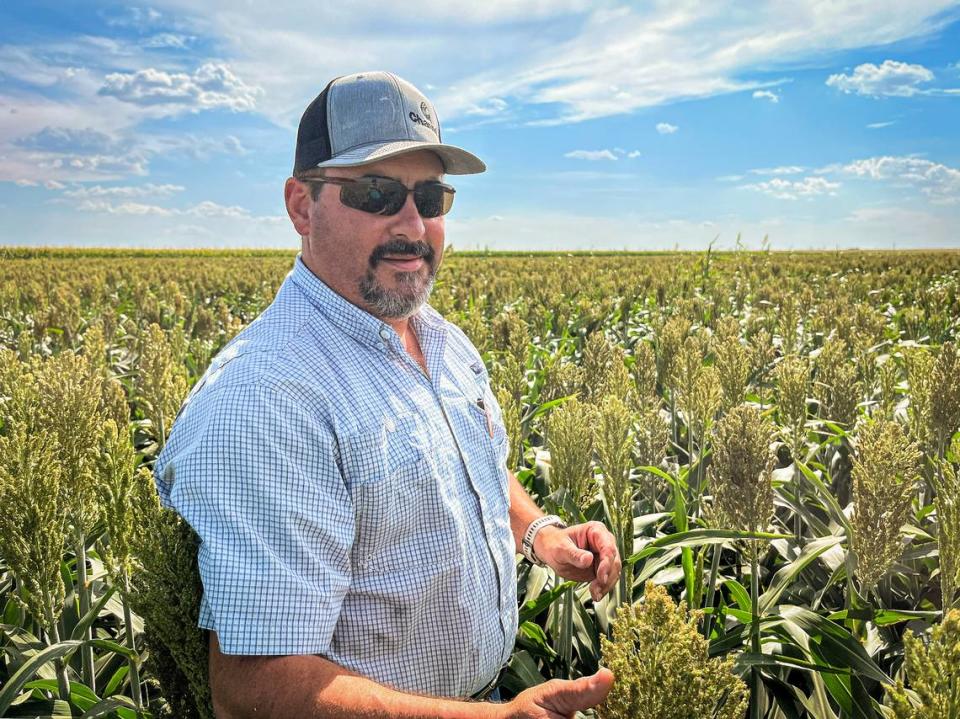
“We knew that if things continued in that direction without change then we were headed towards zero,” said Connie Owen, the director of the Kansas Water Office. “We didn’t have the science. We didn’t have the technology. We didn’t have the public will, we didn’t have the legislative will to face that fact and to try to find a way around it.”
As time passes, many say it’s not a matter of saving the water that has sat in the Aquifer for thousands of years, but extending its lifespan for a couple more.
But Kansas Gov. Laura Kelly, a Topeka Democrat, says she is uniquely positioned to set Kansas on a path toward sustainability.
“I can understand why others didn’t [fix it] for a whole host of reasons but I really would have a hard time living with myself if I did not address what I know to be a huge problem,” Kelly said.
Nevertheless, she remains reluctant to impose any major state mandate on water.
Her solution relies on the same premise as her predecessors: Farmers must voluntarily reduce how much water they use.
Agriculture producers – who use about 94% of the water pulled from the Aquifer – have some culpability in the problem, Peterson said. Just because the speed limit is 65 miles per hour, you don’t go that fast when there’s black ice and white-out conditions. But, he said, the whole state has benefited from the “economic monster” out in western Kansas.
A gallon of water grows a bushel of corn. That bushel goes to the feed yard. The farm has employees and the feed yard has employees. Then it goes to the packing house, where more people work.
“And that’s a lot of churn. Right? That’s a lot of state revenue,” Peterson said. “And kids in school, businesses in town, housing market, taxes, all of it, and it’s just, it’s just the way capitalism works, right?”
Peterson firmly believes that someone will fix the water problem, helping to keep the current farming economy in western Kansas. To think otherwise, he said, would be devastating.
“Entire communities will be decimated,” Peterson said. “Jobs, all of that, will just crumble.”
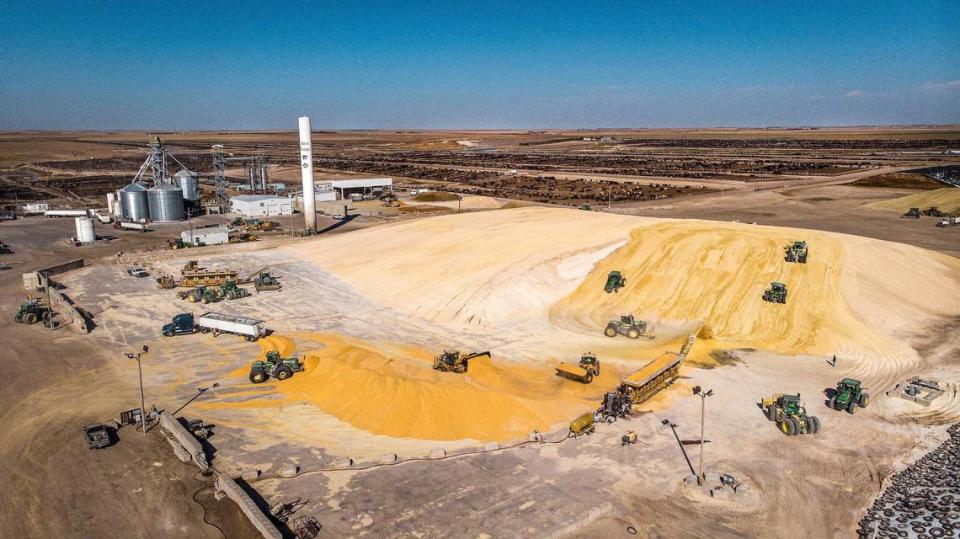
‘The politics were never there’
A blue binder in the Kansas State Library contains a warning from 1955.
The yellowing, type-written pages never mention the Ogallala by name, but they cautioned that, at least in southwest Kansas, the groundwater may not be renewable.
“If total discharge from a ground-water reservoir is so great that it is not balanced by the recharge even in wet years, the storage in the reservoir is inevitably reduced,” researchers wrote. “Ground-water mining is a serious problem.”
Two years later Kansas lawmakers loosened state water law, testing the prophecy.
Before then, the law prevented farmers from draining the Aquifer, because depletion would intrude on older, established water rights. But, with an eye on economics, lawmakers changed the definition of intruding on an older right; a newer water user could deplete the Aquifer as long as it didn’t cost an older water user money.
“The assumption there was that senior water rights would protect themselves… that’s not what happened,” said Burke Griggs, a water law expert at Washburn University.
Politicians – both current and retired – readily acknowledge that the Kansas government helped facilitate the draining of the Ogallala. But for decades the government prioritized short term economics and politics over long term conservation.
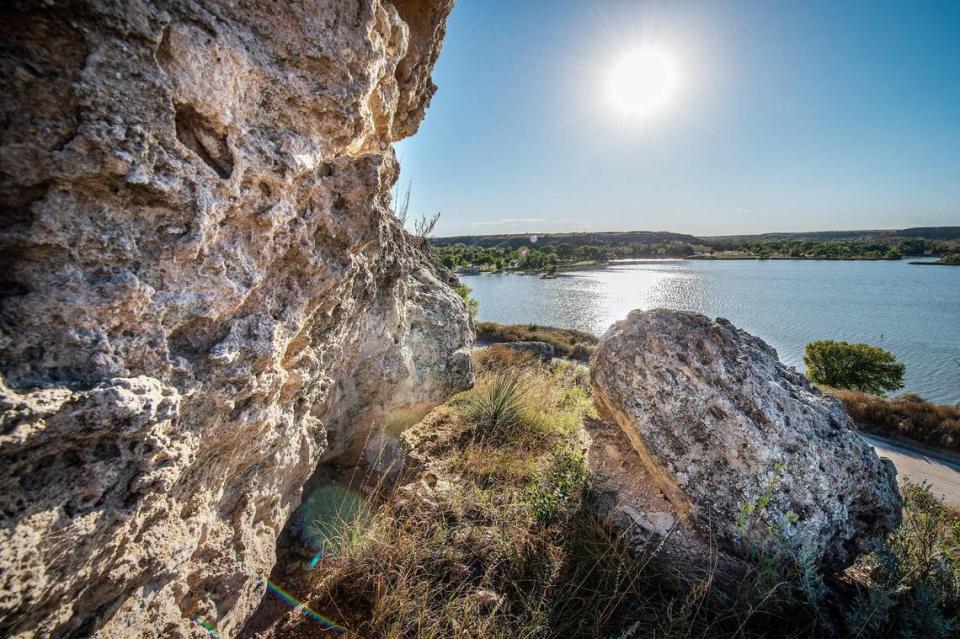
In 1981, after Congress ordered a study on the Aquifer’s depletion, former Gov. John Carlin, a Salina Democrat, told a New York Times reporter the Ogallala’s future was not far from “imminent crisis and doom.”
Speaking to The Star 42 years later, Carlin said the state failed to avoid that crisis. He started the Kansas Water Office, but didn’t impose severe pumping limits and the office wasn’t funded until the next administration.
“The experts understood we had a problem,” he said. “The masses weren’t ready and so the politics was never there.”
That remained true more than 15 years later when former Gov. Kathleen Sebelius, a Topeka Democrat, told the Star this year she did not prioritize water because the crisis wasn’t immediate. Even if she had sought to address the issue with executive regulations, Sebelius believed the Republican-controlled Legislature would have objected.
She called it a failure not to have tried to solve the problem while she could, because she thinks it will only be fixed by the government.
Republican Gov. Sam Brownback wanted to focus on water. He worked on the issue as agriculture secretary, but said even writing a report on the Aquifer was “seen as very aggressive.”
As governor, Brownback developed Kansas’s 50 year water plan, but — amid major budget shortfalls — it wasn’t funded. He doesn’t think that funding would have made a difference.
“The water plan funding would have been helpful, but most of these are individual or community decisions on whether you’re going to pump or not,” he said.
In the absence of significant intervention from Topeka, local water users pushed for more power, particularly as they felt officials were cavalier in approving new wells.
“You had wells on each side of the county road,” said Clay Scott, the owner of West Acres Grain. “It made no sense. Why isn’t there spacing? Well, because there was no need because nobody complained yet.”
Scott’s region – southwest Kansas – is widely regarded as one of the most resistant to changes in water policy. It’s also where the Ogallala is the deepest.
It is easy to think of an Aquifer as an underground lake, connecting the land underneath the High Plains. It’s not.
“The Aquifer itself is not a big hole in the ground, a big cavern, at least in our state, that you can go swim around in,” said Brownie Wilson, a geohydrologist with the Kansas Geological Survey. “It’s sands and gravels that have filled up over years.”
Instead, Wilson said, you should think of it as a series of peaks and valleys. The impermeable bottom layer is deep in some areas – close to 600 feet – and shallow in others – like 50 feet.
Water moves, of course. But because of all the silt and sand and gravel, the water moves very slowly, only about a foot a day – a mile in 15 years. So if a farmer in southwest Wyoming is draining his wells, it won’t affect a farmer trying to conserve water in southwest Kansas.
The Ogallala aquifer is the principal source of water for agriculture in western Kansas.
It’s not an underground lake as some believe but saturated sediments that have been deposited over the past 35 million years.
When we pull water from the aquifer, it’s a bit like sucking water out of a sponge made of rock, gravel, sand and other geologic materials.
High capacity irrigation, such as center pivot sprinklers, have used groundwater faster than it can be replenished.
Center pivot sprinklers can disperse hundreds of gallons per minute from a well, 24 hours a day, for weeks or months on end.
Some wells in western Kansas have been abandoned as underground water levels have dropped significantly.
Because of its slow movement, there aren’t multi-state compacts for the Ogallala, even though it spans from Wyoming to Texas. There’s no standard between states on how to conserve Aquifer water and, even if there was, the federal government can’t step in if the states disagree, the way it has with southwestern states negotiating over the Colorado River.
That makes it a local problem, turning it from something argued between state governments to one that requires a pact between neighbors.
But locally, water rights aren’t clear cut; it’s a tangled web where farmers often own older and newer rights. If someone went to court to prevent their neighbor with newer water rights from overpumping, it could create a ripple effect that would threaten their own newer wells.
In the 1970s – when groundwater withdrawals were at their peak – the Legislature passed a law that allowed irrigators to form groundwater management districts, also known as GMDs, lending cooperative power to efforts to reduce water use.
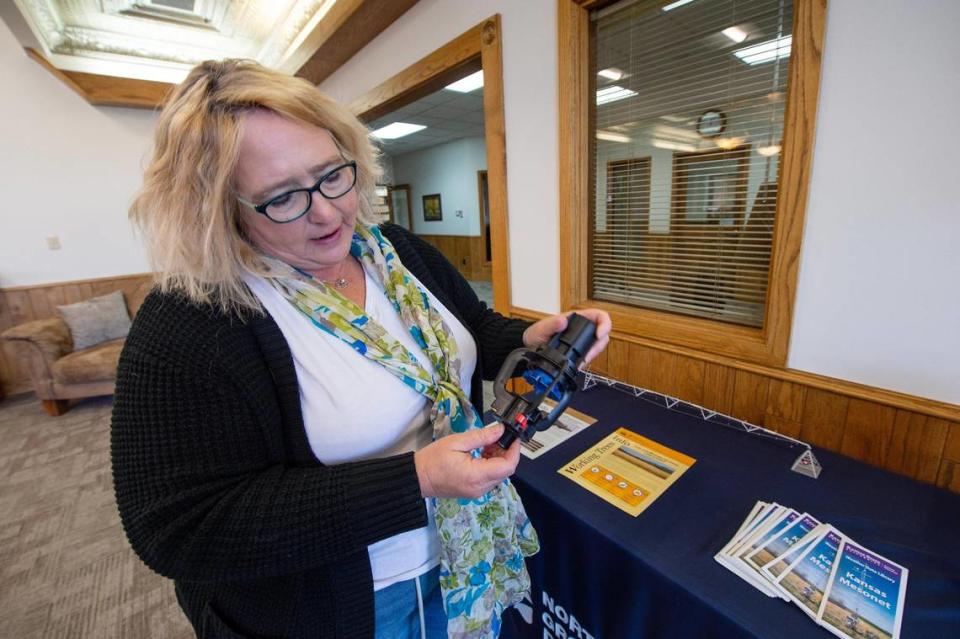
There are five GMDs in Kansas – three cover areas where water is supplied by the Ogallala. Voting members of the district own irrigated land, which means residents without irrigation rights have no direct say in how their water is managed.
At first, the districts could only recommend policy changes to the state and require users to install and monitor water meters. But, after farmers and feedlot managers in northwest Kansas asked for more control over pumping limits, the Legislature passed a new law in 2012 that would allow irrigators to set limits and mandate conservation: Local Enhanced Management Areas, or LEMAs.
LEMA restrictions have extended the lifespan of the Ogallala in northwest Kansas but they only impact water within their boundaries – a farmer with land inside and outside a LEMA can simply move their wells.
Earlier this year the Legislature required groundwater management districts to identify how to best protect their water by 2026. If that doesn’t happen, Earl Lewis, the chief engineer in the Kansas Department of Agriculture, says the state will step in with more serious action, likely a mandate requiring cut backs on water use.
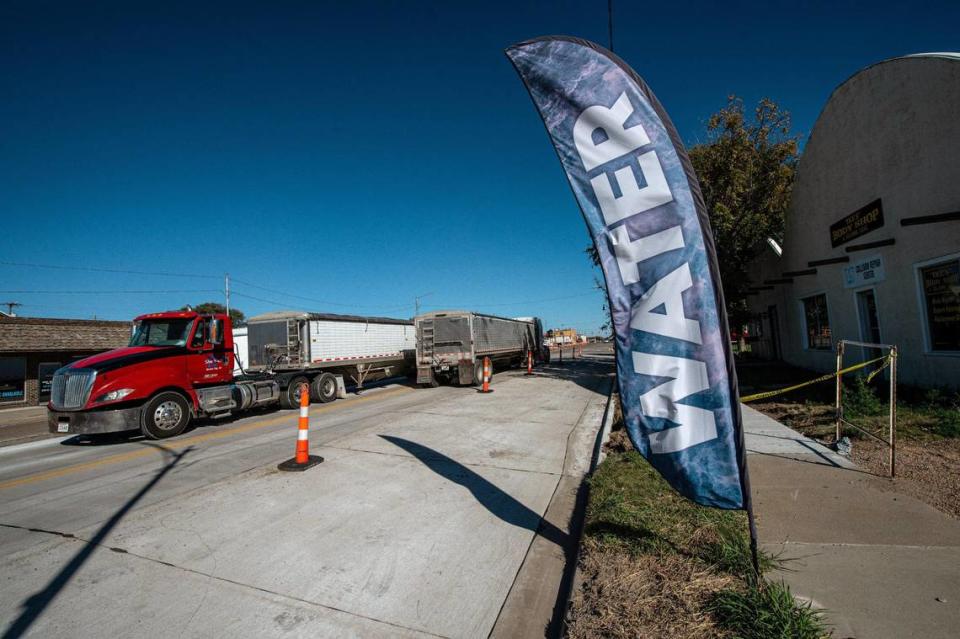
It doesn’t scare Mark Rude, the executive director of the Southwest Kansas GMD.
“The chief engineer’s had full authority to deal with these issues for decades,” Rude said. “And it hasn’t happened. And so whatever process ends up with, as long as it is reasonable, will be acceptable. So will it fix the problems? Probably not. Will it address them? Certainly. Will it be enough? Time will tell.”
Rude can point to several reasons he doesn’t want the state stepping in. If you mandate across the board cuts, he said, you’re punishing people who have already reduced their water use because they would have to cut the same percentage as people who haven’t saved water at all. He said the threat of government intervention incentivizes people to pump more because it gives more room to cut back.
Instead, Rude wants financial compensation for people who conserve water. And his GMD has pushed a plan to take water from the Missouri River, recharge the Aquifer and sell the rest to Colorado. Officials have dismissed the plan as unrealistic.
Others – like Vijay Ramasamy, Kelly’s special advisor for water – hope that as LEMAs prove that farmers can cut water use while still producing profitable crops, it will convince other water users that more conservation is possible.
Rep. Jim Minnix, a Scott City farmer and Republican chair of the House Water Committee, said he’s hoping to use current momentum to make up for decades of lost time before the Aquifer gets so low that water quality becomes a bigger concern. The Legislature infused a historic amount of funding into water conservation this year.
“It should have been dealt with a long time ago,” Minnix said. “With what we’re dealing with today I want to do everything we can to get to that static point as soon as we can.”
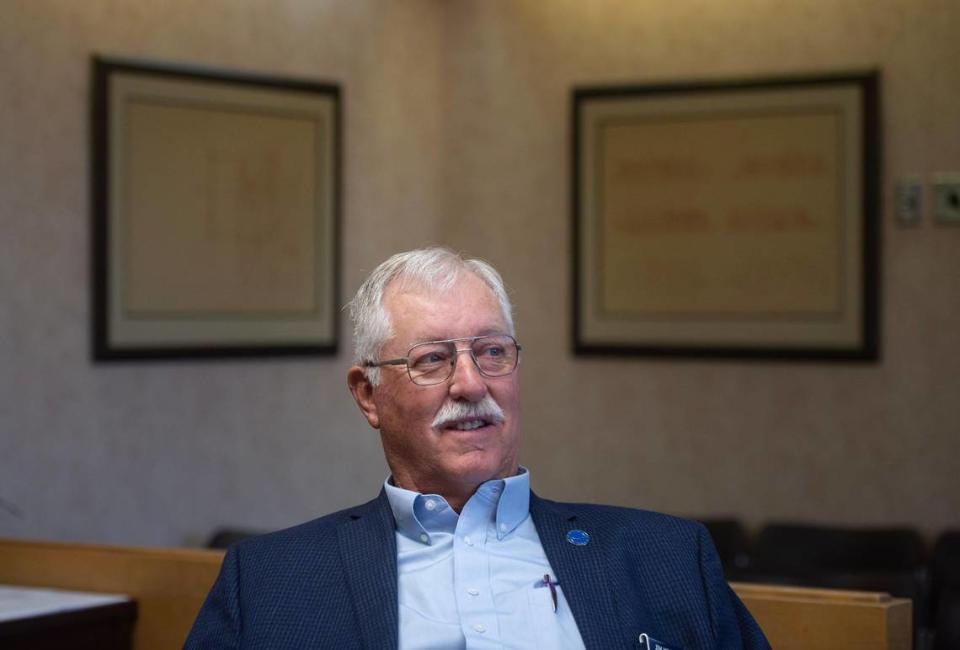
Kansas’s chief engineer has long had the authority to impose sweeping restrictions to protect older water rights from infringement by newer water rights. If the situation is particularly dire, he could establish a high priority conservation area and limit pumping for the entire Ogallala region.
But Lewis said he’s reluctant to issue a mandate because it has always lacked public support and he’d be obligated to prove he’s acting in the public interest. For decades, he said, there was more support for mining the Aquifer than saving it.
The agriculture community, which draws the majority of the water from the Aquifer, also holds significant power over policies that would drastically reduce water use. Kansas chief engineer is under unique political pressure. Unlike in other states, the engineer is hired by the Secretary of Agriculture, a political appointee.
The secretary cannot fire the chief engineer but they can overturn some of their decisions. And, at this point, the governor has made it clear she doesn’t want her administration to mandate cuts.
“You don’t solve problems by forcing,” Kelly said. “Let’s say it solves the water problem, the other problems that it would create would be massive and I’m not sure redeemable.”
That leaves one solution: The agriculture industry has to make cuts.
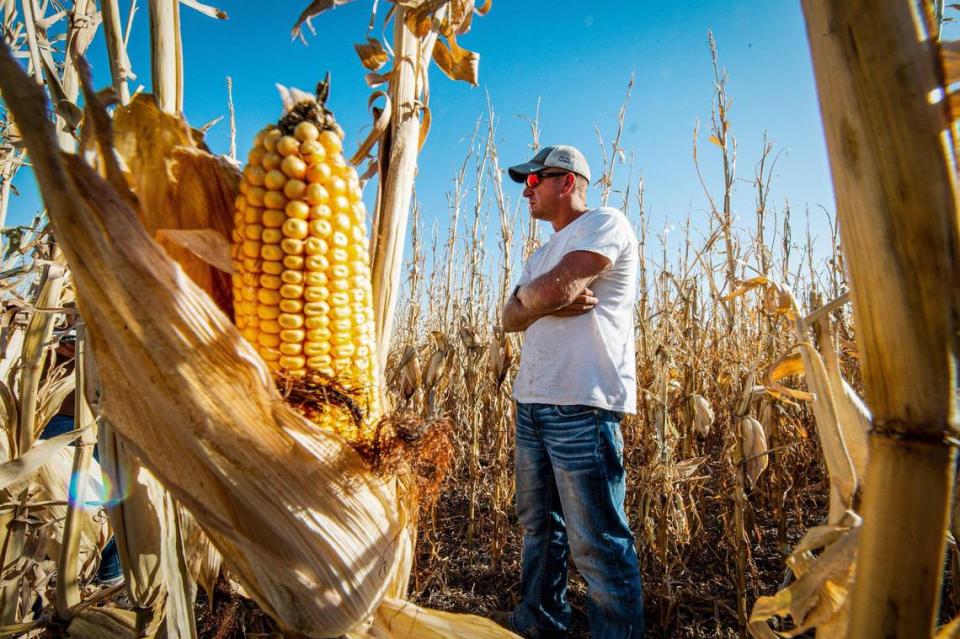
Efficiency is key
This year was wet in southwest Kansas. Farms in Finney County got more rain in three months than they had the past year. In August, ditches on the side of the road still had water in them, weeks after the last rain.
But because the region is semi-arid, most years are pretty dry. Between 2021 and 2022, much of western Kansas faced extreme drought conditions. Raccoons nibbled through the plastic of Peterson’s irrigation system, searching for water and taking it from his crop.
Efficiency is key to nearly all of the plans to save the Aquifer. The agriculture community can cut its water use through new technologies – genetically modified crops that drink less, pesticides that knock out weeds and advanced irrigation systems.
Irrigation systems have evolved from flooding entire fields to center pivot systems with flexible plastic tubes that water crops at the base.
In Sheridan County, where Brett Oelke farms, wells in the region have been incapable of pulling all the water they’re allowed for years. Oelke’s father and grandfather placed meters on their wells before it was required. The decline was clear.
“I could have rode off irrigation into the sunset and been the last Oelke to irrigate corn in Sheridan County,” Oelke, whose farm is in a LEMA district, said.
When he spoke with The Star in October, Oelke was changing the heads on his sprinkler to a more efficient design. He’s also conserved water by changing his planting patterns, leaving the debris from the prior crop on the soil to limit evaporation. Since he made this shift, Oelke’s farm has made more money. His yields aren’t as high but he’s spending less money on the front end.
Irrigated land has more value than dryland, when crops depend on rain rather than irrigation. So when a farmer stops using a well, they lose value.
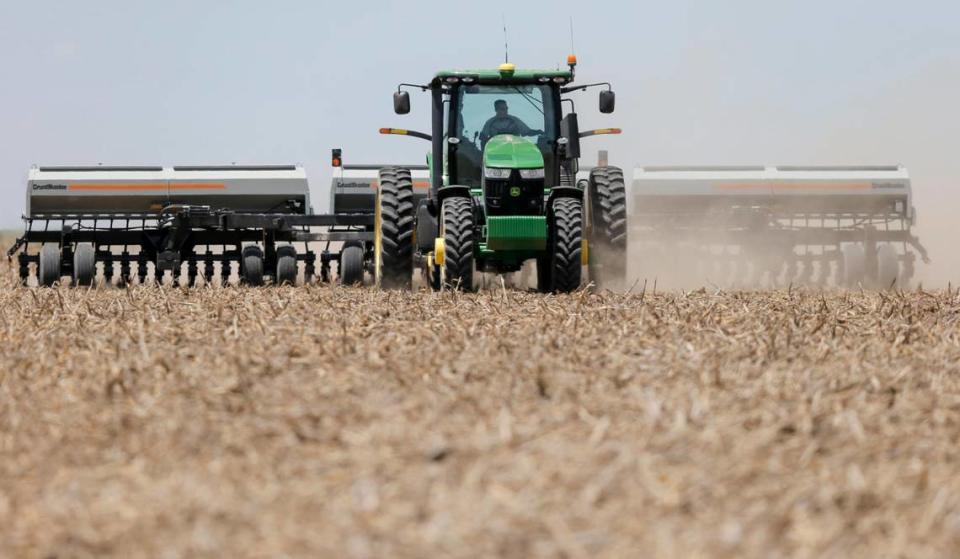
Matthew Sanderson, a social science professor at Kansas State University, found that two things drive a farm’s profit – if they irrigate their crops and if they get government subsidies.
Kansas farmers received more than $27.6 billion in federal farm subsidies between 1995 and 2021, according to the Environmental Working Group, an environmental activist group that opposes subsidies.
Federal subsidies are based on the market values of crops. So growing corn, which has a high market value in Kansas, can mean a farmer still gets a decent return in a bad season.
For years former Sen. Pat Roberts, a Kansas Republican, was the highest ranking Republican on farm policy. He hoped to use that power to build a coalition to get federal subsidies or incentives for farmers to switch to more efficient irrigation technology. It never came together.
“We would always have something else come in away and it just didn’t happen,” Roberts said. “And that’s, that’s very regrettable.”
The state and federal government have offered hundreds of millions to farmers in programs that incentivize them to use less water and conserve the land. In late October, the Biden administration announced a $24.9 million grant for the Kansas Department of Agriculture to specifically deal with Kansas groundwater.
It still may not be enough. One GMD manager said she gave out $65,000 in cost share incentives last year. It was only about a third of the demand.
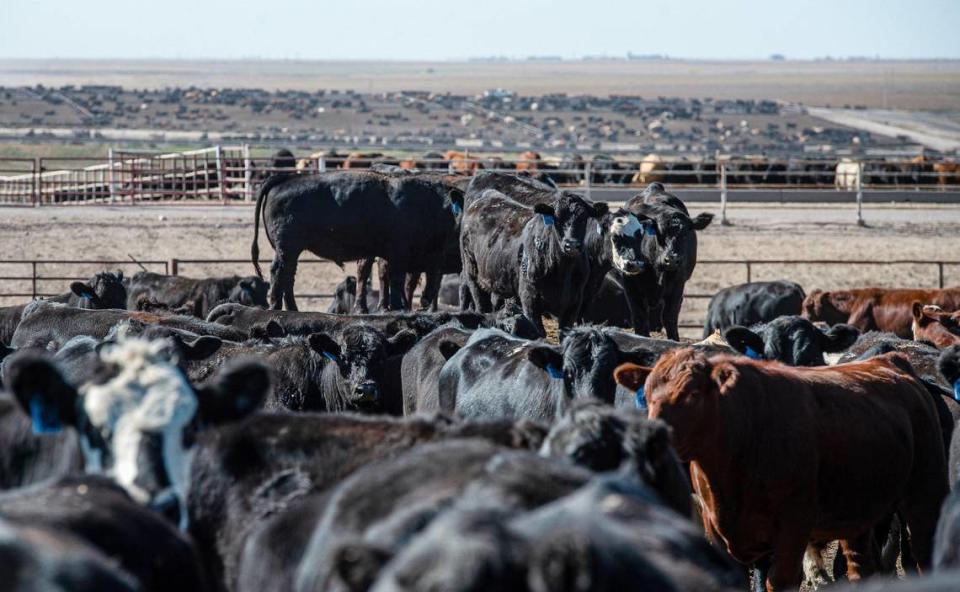
Reverence for farmers
For all of the attempts at a solution, the alphabet agencies and the technological advances, there’s a big reason it’s been easy for politicians to stay out of the way: A lot of people don’t want outsiders getting involved.
They don’t want the chief water engineer. Nor the Legislature. Nor the governor. And certainly not the federal government.
Over trips to western Kansas people repeatedly said the problem should be solved locally.
“Nobody in Topeka knows what in the world is going on out here,” Shannon Kenyon, who manages the Northwest Kansas GMD, said. “They think we just do what we do throughout the day, we start drinking beer at two o’clock in the afternoon and drive around in pickups all day. And that’s not how it works out here.”
It’s a long-held sentiment. For years, as Roberts was hoping he might be able to get something done in Congress to address the water issue, he was warned off by constituents.
“In southwest Kansas, you didn’t want to touch that third rail,” Roberts said. “They always worried about a mandate coming down from Washington that would put them out of business.”
Farmers have long held power in the American political imagination, to the point where working the land is more than a profession – it’s a national identity.
“We revere farmers,” Sanderson said. “They’re a part of a national myth about who we are as a country. They went out, they tamed the land, they subdued it, they used it. And they are the basis for democracy, according to Jefferson.”
Sanderson said preserving the Aquifer involves a series of challenges. You have a technical challenge, of trying to make irrigation and crops more efficient to reduce water use. You have an economic challenge both in making the economy of western Kansas work without irrigated farmland and without driving up food costs. You have a political problem, determining whether to step in and save the Aquifer.
And then there’s the challenge of farming culture.
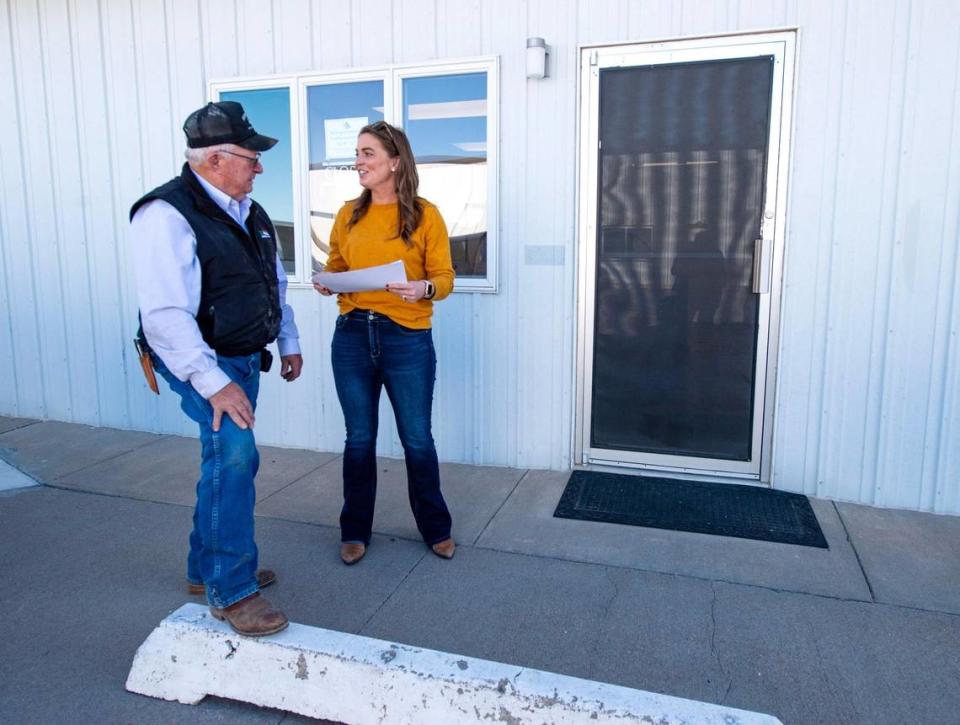
Kansas has the 7th highest agricultural production of any state – much of it irrigated by the Ogallala, which accounts for 75% of the groundwater use in the state. There’s a sense in western Kansas that the eastern part of the state ignored the Aquifer depletion while simultaneously blaming farmers.
“People in urban areas, they don’t know what they don’t know,” said Katie Eisenhour, who runs economic development in Scott County. “We’re not misusing water when we’re trying to grow your food.”
Northwest Kansas isn’t close to reaching the level where they stop taking out more water than is replenishing the Aquifer, a concept referred to as sustainable yield, static or status quo. But after slow, and sometimes painful culture change, farmers have doubled the lifespan of the Aquifer in that area.
In the early days of local restrictions, Kenyon worried about slashed tires after meetings. Now, some of her biggest adversaries brag about their conservation.
And, as more people recognize a changing climate, it has become clear that water is a finite resource. Amid political battles over access to water in the southwest, the governor plans to take advantage of the recent attention, her political capital and the state’s budget surplus.
“It’s one of those things that has to be done or there’s no Kansas, or certainly not Kansas like we know today,” Kelly said.
To lose water, to lose the ability to farm, is akin to losing one’s identity.
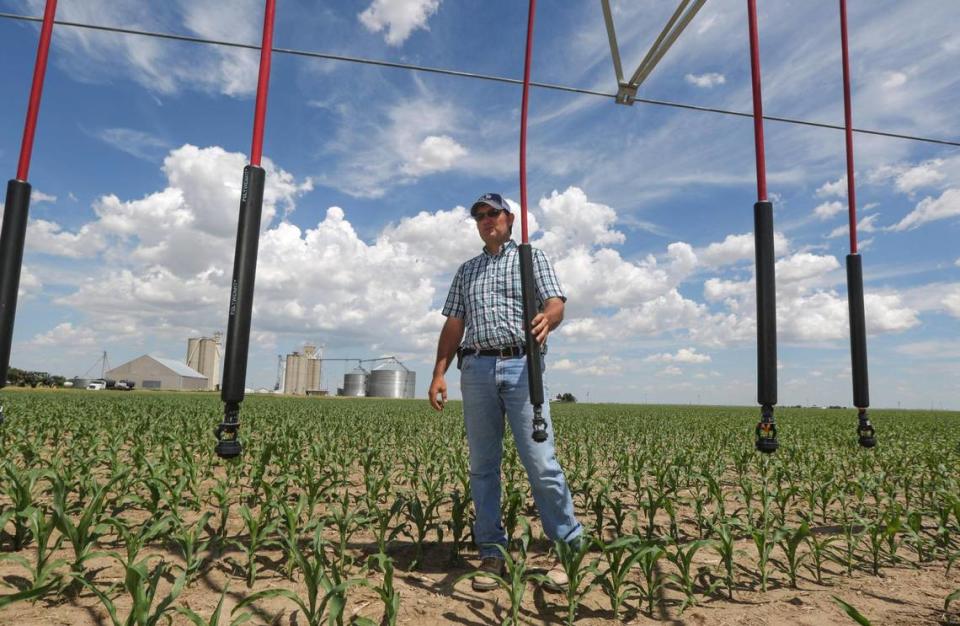
Sen. Jerry Moran, a Kansas Republican, mused about what western Kansas would look like if farmers can’t produce a profitable crop. Already, there’s a mental health crisis among farmers.
“There’s a depression that can come from your inability to do what your predecessors, what your family members did,” Moran said.
“While I tell you the depression that comes from that, there’s as many farmers who would say, ‘it’s gonna rain. It always does,’” Moran said. “I mean, I’ve heard that hundreds of times.”
Few people were willing to speculate on what it would mean if the Ogallala dried up.
That’s partially because the water won’t dry up all at once – some areas have more than 100 years left. It’s also because it’s still possible to transition away from irrigation – while the water is ancient, reliable irrigation is a relatively modern invention.
There was speculation about what it would mean for food costs (they’d skyrocket) and the Kansas economy (it’d crater) if the region can’t successfully transition to dryland crops. There are sandy regions in western Kansas where dryland farming might not work. Or something might grow, but it wouldn’t be profitable.
“If we don’t change our behaviors, and change them enough, there will be no Ogallala Aquifer for us to use,” Owen, the head of the water office said. “There’ll be nothing. There will be no agriculture. There will be no communities. There will be nothing. There will be no hospitals, no schools, no towns.”
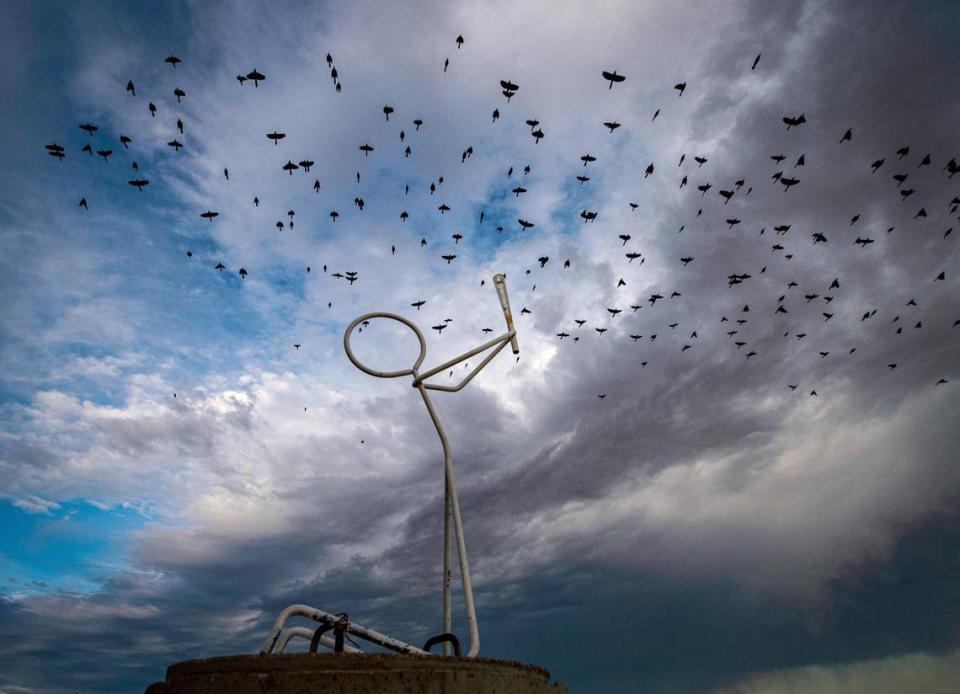
But farmers are optimistic. The Northwest Kansas GMD not only found a way to reduce water use, it’s shown that it can be profitable. There’s new technology every day. There’s political momentum.
In other words, it’s gonna rain. It always does.
McClatchy’s David Newcomb created graphics, The Star’s Neil Nakahodo created illustrations and The Star’s Chris Ochsner made photographs for this article.

